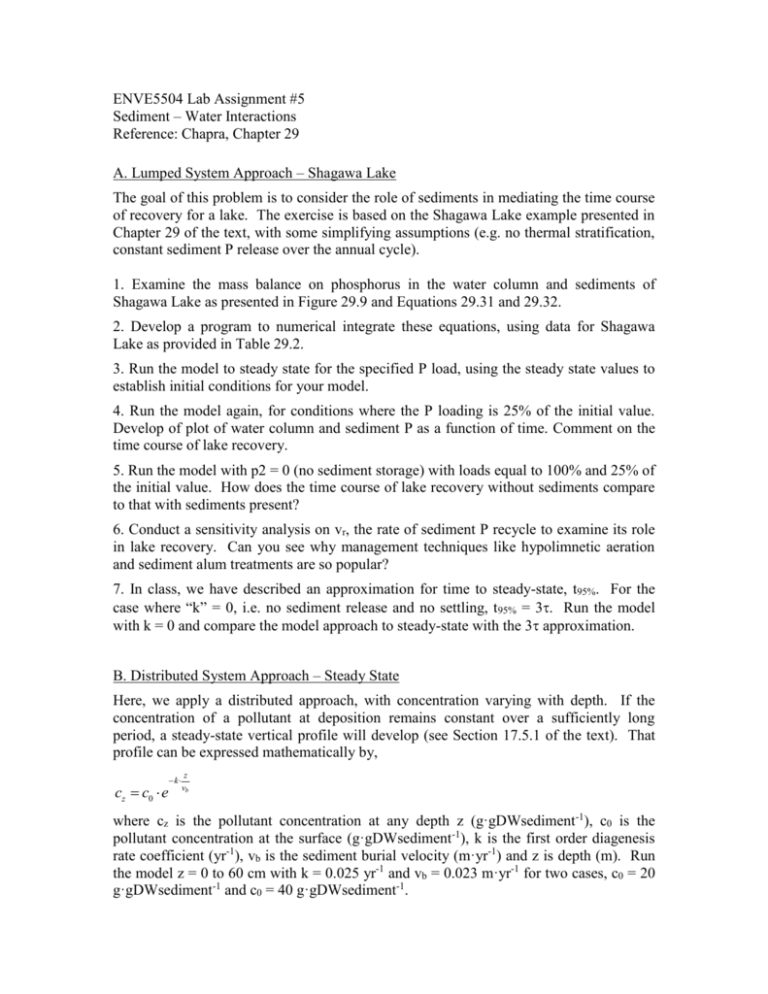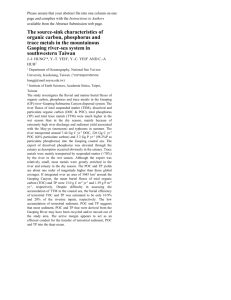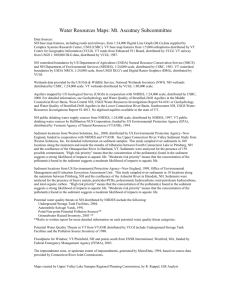Sediment – Water Interactions
advertisement

ENVE5504 Lab Assignment #5 Sediment – Water Interactions Reference: Chapra, Chapter 29 A. Lumped System Approach – Shagawa Lake The goal of this problem is to consider the role of sediments in mediating the time course of recovery for a lake. The exercise is based on the Shagawa Lake example presented in Chapter 29 of the text, with some simplifying assumptions (e.g. no thermal stratification, constant sediment P release over the annual cycle). 1. Examine the mass balance on phosphorus in the water column and sediments of Shagawa Lake as presented in Figure 29.9 and Equations 29.31 and 29.32. 2. Develop a program to numerical integrate these equations, using data for Shagawa Lake as provided in Table 29.2. 3. Run the model to steady state for the specified P load, using the steady state values to establish initial conditions for your model. 4. Run the model again, for conditions where the P loading is 25% of the initial value. Develop of plot of water column and sediment P as a function of time. Comment on the time course of lake recovery. 5. Run the model with p2 = 0 (no sediment storage) with loads equal to 100% and 25% of the initial value. How does the time course of lake recovery without sediments compare to that with sediments present? 6. Conduct a sensitivity analysis on vr, the rate of sediment P recycle to examine its role in lake recovery. Can you see why management techniques like hypolimnetic aeration and sediment alum treatments are so popular? 7. In class, we have described an approximation for time to steady-state, t95%. For the case where “k” = 0, i.e. no sediment release and no settling, t95% = 3. Run the model with k = 0 and compare the model approach to steady-state with the 3 approximation. B. Distributed System Approach – Steady State Here, we apply a distributed approach, with concentration varying with depth. If the concentration of a pollutant at deposition remains constant over a sufficiently long period, a steady-state vertical profile will develop (see Section 17.5.1 of the text). That profile can be expressed mathematically by, cz c0 e k z vb where cz is the pollutant concentration at any depth z (g·gDWsediment-1), c0 is the pollutant concentration at the surface (g·gDWsediment-1), k is the first order diagenesis rate coefficient (yr-1), vb is the sediment burial velocity (m·yr-1) and z is depth (m). Run the model z = 0 to 60 cm with k = 0.025 yr-1 and vb = 0.023 m·yr-1 for two cases, c0 = 20 g·gDWsediment-1 and c0 = 40 g·gDWsediment-1. The result of these calculations will yield pollutant profiles for a ‘polluted’ case (c0 = 40) and a ‘remediated’ case (c0 = 10). Examine the profiles to see what you can learn from this exercise. What limits does the steady state case impose? C. Distributed System Approach – Time Variable Finally, we seek to resolve some of the shortcomings of the steady state approach. The tool that we will employ for this purpose is a versatile, time-variable model of particulate organic matter diagenesis in sediments developed by Dr. Steve Chapra and myself. In this classroom application, we will seek to streamline our application of the model to minimize complexity and maximize learning opportunities. The model interface has been set up to be coordinated with the previous exercise. The values of k [RATES TAB] and vb, calculated based on the sedimentation rate [UPBC TAB] and the sediment porosity and dry density [SED CHAR TAB] and output as a velocity [BVDP TAB], are as for the previous exercise. The initial concentration is calculated by SED2K as the pollutant flux (JPOC, gDW·m-2·yr-1) divided by the sedimentation rate (JTSS, gDW·m-2·yr-1) [UPBC TAB]. The values, as provided, will yield a value of c0 = 40, i.e. equivalent to the previous exercise. The objective of this exercise is to establish downcore profiles and time series of efflux for the ‘polluted’ (c0 = 40) and ‘remediated’ (c0 = 10) cases. The ‘remediated’ case value for c0 may be achieved by reducing JPOC by 75% [UPBC TAB]. For these two runs, the profile initial conditions [IC TAB] are set and zero and the model builds in to the steady state solution. Next, a remediation run is made. The profile initial conditions [IC TAB] for the c0 = 10 case are input from the steady state profile [OP TAB] for the ‘polluted’ case. Here, you will need to select a subset of the output provided to serve as your initial condition. Do not input more values than are already present and do not exceed 60.0 cm. By setting the value for JPOC at the ‘remediated’ value and the initial conditions at the ‘polluted’ value, you will be able to observe changes in the pollutant concentration and efflux as the system moves to its new, remediated steady state. Make a series of runs with: (1) the end time close to the start time and (2) the end time at 1/1/1995 to observe the end member results for the time-variable simulation. Then make runs for three intervals between the two steady state conditions to examine changes in the shape of the profile as the system moves to a new steady state. Copy the efflux times series and the five output profiles (appropriately labeled) to a Powerpoint file. Wrap-up: discuss in small groups of 2-3 how this version of SED2K might be extended to include simulation of soluble phase constituents and how that extension would support water quality management.







